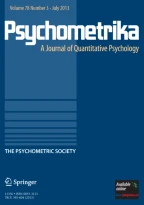Abstract
In the situation where subjects independently rank order a fixed set of items, the idea of a consensus ordering of the items is defined and employed as a parameter in a class of probability models for rankings. In the context of such models, which generalize those of Mallows, posterior probabilities may be easily formed about the population consensus ordering. An example of rankings obtained by the Graduate Record Examination Board is presented to demonstrate the adequacy of these generalized Mallows' models for describing actual data sets of rankings and to illustrate convenient summaries of the posterior probabilities for the consensus ordering.
Similar content being viewed by others
References
Arrow, K. J. (1950). A difficulty in the concept of social welfare.Journal of Political Economy, 38, 328–346.
Birch, L. L. (1980). Effects of peer models' food choices and eating behaviors on preschoolers' food preferences.Child Development, 51, 489–496.
Cohen, A., & Mallows, C. L. (1983). Assessing goodness of fit of ranking models to data.The Statistician, 32, 361–373.
Critchlow, D. E. (1985).Metric methods for analyzing partially ranked data. New York: Springer-Verlag.
Daniels, H. E. (1950). Rank correlation and population models.Journal of the Royal Statistical Society, Series B, 12, 171–181.
David, H. A. (1963).The method of paired comparisons. New York: Hafner.
de Borda, J. C. (1781). Memoire sur les elections au scrutin.Histoire de l'Academie Royale des Sciences. [A report on voting by ballot. History of the Royal Academy of Sciences].
Diaconis, P. (1987). Group representations in probability and statistics. Haywood, CA: Institute of Mathematical Statistics.
Feigin, P. D., & Cohen, A. (1978). On a model for concordance between judges.Journal of the Royal Statistical Society, Series B, 40, 203–213.
Feller, W. (1968). An introduction to probability theory and its applications (Vol. 1, 3rd ed.). New York: John Wiley & Sons.
Fishburn, P. C. (1973). The theory of social choice. Princeton: Princeton University Press.
Fligner, M. A., & Verducci, J. S. (1986). Distance based ranking models.Journal of the Royal Statistical Society, Series B, 48, 859–869.
Fligner, M. A., & Verducci, J. S. (1988). Multistage ranking models.Journal of the American Statistical Association, 83, 892–901.
Kendall, M. G. (1970).Rank correlation methods (4th ed.). London: Griffin.
Loukas, S., & Kemp, C. D. (1986). On the chi-square goodness-of-fit statistic for bivariate discrete distributions.The Statistician, 35, 525–529.
Luce, R. D. (1959).Individual choice behavior. New York: John Wiley & Sons.
Mallows, C. L. (1957). Non null ranking models I.Biometrika, 44, 114–130.
Mosteller, F. (1951). Remarks on the method of paired comparisons: I the least squares solution assuming equal standard deviations and equal correlations.Psychometrika, 16, 3–9.
Plackett, R. L. (1975). The analysis of permutations.Applied Statistics, 24, 193–202.
Thurstone, L. L. (1927). A law of comparative judgment.Psychological Reviews, 34, 273–286.
Author information
Authors and Affiliations
Additional information
The authors thank Leann Birch for permission to refer to her experiment on cracker preferences, and the Graduate Record Examination Board for permission to use primary data from the Pike Report in our example. We also thank the referees for helpful comments.
Rights and permissions
About this article
Cite this article
Fligner, M.A., Verducci, J.S. Posterior probabilities for a consensus ordering. Psychometrika 55, 53–63 (1990). https://doi.org/10.1007/BF02294743
Received:
Revised:
Issue Date:
DOI: https://doi.org/10.1007/BF02294743
